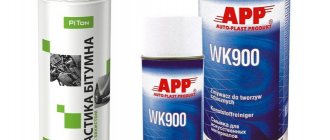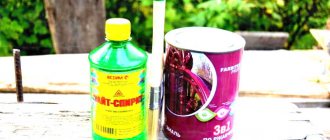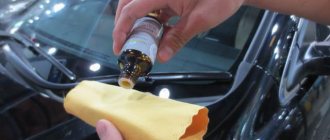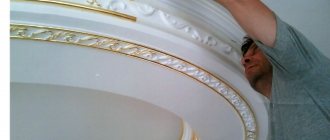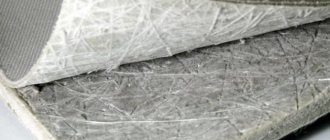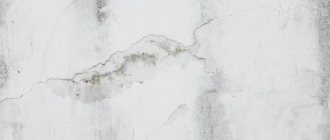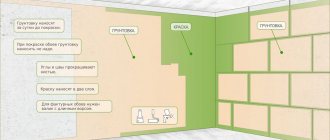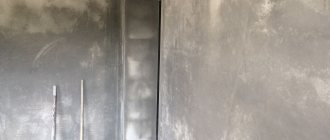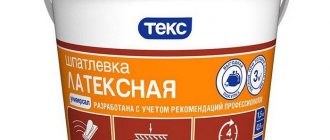Why is the procedure necessary?
Before determining methods and means, you need to understand the need for the event. Oily stains are a thin film that is not always visible. It appears over time in almost any operating conditions of a particular product or equipment.
Technically, the formation is represented by a dense, almost impenetrable coating. It does not allow moisture to pass through, which prevents paint from penetrating deep into the working surface. Also, due to the high degree of smoothness and low adhesion with various types of painting materials, the coating material rolls off and drops form.
Also, oils and fats have little contact with the metal surface. Because of this, the applied decorative composition peels off from the base. As a result, degreasing the metal surface before painting is a necessary measure to obtain a high-quality result.
One of the options for the behavior of paint on an oily surface Source nervous.com
See also: Catalog of companies that specialize in paints and varnishes and related work
What is defatting?
Degreasing is a special procedure that is performed to remove fatty substances from the surface. Many paint and varnish compositions react negatively to fat particles that remain after touching, etching, and washing. This causes the dried paint to crack.
Fatty contaminants are divided into three groups depending on the degree of accumulation. They can be weak, medium, or increased.
Methods and means for degreasing metal
Let's consider how and with what to degrease metal before painting. Products suitable for the procedure may have different compositions and consistencies. But all of them are suitable for work on a construction site, which is not limited to industrial conditions.
Techniques
The choice of method is determined by the degree of contamination of the working surface. Conventionally, there are three levels: 1, up to or more than 5 grams per square meter. meter of cultivated area. The decision on how to degrease the surface before painting also depends on this. Let's take a closer look at each of the methods:
- Mechanical. Here the main advantage can be considered the creation of a rough surface, which has a positive effect on the overall adhesion of the paintwork material to the base. For work, hand tools or electric analogues are used: sandpaper, a brush with metal bristles, or alternative attachments for an angle grinder. The disadvantages of the method are labor-intensive, dusty and inadequate removal of the fatty film.
Nozzle for metal cleaning of metal Source krepezhnydom.ru
- Chemical. Here the film is affected by special liquid agents. A chemical reaction occurs between the compound and the oil, which results in a destructive effect on plaque without affecting the metal. Residues are subsequently removed mechanically or washed off. The main advantage of the technique is that no physical effort is required, the work takes relatively little time.
- Electrochemical. Here, along with liquid agents, the surface is exposed to an electric charge. In the private sector, the method is not common, since strict conditions for the procedure must be observed. They are created at enterprises. In terms of effectiveness, the method is considered the best, since plaque is removed without residue. But any deviation from the technology leads to damage to the metal surface.
The first two methods are acceptable for use in a home workshop, inside a living space. As a rule, they are combined. First, the structure of the fat formation is destroyed, then it is removed using instruments. For painting metal yourself, this is often enough.
Mechanical degreasing with grinding equipment Source siteapi.org
Methods for degreasing metal before painting
There are various methods for cleaning metal. They differ in technique, cost and effectiveness.
It is possible to use special tools or degreasing agents. The procedure will require a minimum of time, but the painting will be of higher quality and more reliable. Cleaning methods are divided into 3 categories: mechanical, chemical and electrochemical.
Simple and affordable means
When thinking about how to degrease metal before painting, gasoline, kerosene, acetone, and alcohol immediately come to mind. These remedies have been used for a long time and have become traditional. These are the most affordable ways to clean metal.
White Spirit
The most common use of white spirit is to degrease metal surfaces.
This is due to its availability and drying speed. Immediately after application, the base is ready for priming and painting. The product is also used to dilute paints and varnishes. White spirit copes well with fatty deposits and residues of organic compounds. However, the product has an unpleasant odor, which is why it is used only in ventilated areas or outdoors. Important! When degreasing metal with white spirit, avoid direct sunlight on the surface.
Acetone
Acetone is used less frequently. This product also effectively removes oil and grease stains, but it should be used carefully, since the composition reacts with some chemical compounds, which can lead to a change in the quality characteristics of the surface. Acetone has an unpleasant odor, so it should be used with caution. The composition contains alcohol, which promotes rapid drying.
Solvent 646
Like white spirit, solvent 646 has an unpleasant odor. The product can effectively cope with pollution. Degreasing metal before painting must be done with gloves, masks, respirators, preferably in the open air, since the composition is explosive and fire hazardous. When applying solvent 646, temperature conditions must be observed: from +5 to +30°C. Humidity should be no more than 85%. If the requirements are met, the surface will be uniform, without streaks, with a glossy effect.
Kerosene
You can degrease metal before painting only with kerosene with a high purity rating. Compositions with impurities are not used for degreasing. Almost everyone has kerosene, acetone and alcohol. The product is only suitable for small metal areas. Large areas are better treated in other ways.
Alcohol
Alcohol-based products are often used for degreasing because it is volatile and the surface dries quickly, which reduces preparatory procedures. Ethyl alcohol, ammonia, and isopryl alcohol itself are also used to degrease metal. The latter is more effective because it is not absorbed into the surface. Sometimes this tool is combined with a mechanical method to achieve a better result.
Petrol
Acetone, gasoline, and kerosene are similar, but have different functionality. Using gasoline will remove grease stains most effectively, since the product does not leave stains. It is more often used in everyday life. The disadvantages include the dense structure of the substance, which complicates its use.
Chemical methods
Of all the available cleaning options, chemical methods are considered the most effective, since they allow you to efficiently remove residual fat deposits and oil stains from a metal surface. Solvents are often used in everyday life. This method is less popular in manufacturing plants due to the risk of explosion. One of the disadvantages of using solvents is also the inability to remove abrasive particles.
Alkalis
Alkaline solutions effectively degrease metal. They are environmentally friendly and fireproof. When applied to the surface, contaminants are peeled off and removed along with the applied liquid. Metal after treatment with alkali requires an anti-corrosion coating. Some alkaline solutions require heating. In this case, a hair dryer will come in handy.
Important! To preserve the decorative properties of the metal, you should carefully read the composition of the alkaline product, since it may contain components harmful to the metal.
Antisilicone
This product is ideal for processing glass.
Antisilicone is also suitable for degreasing car bodies.
It effectively removes oil and grease stains. Also suitable for other types of surface: rubber, plastic. Various options are available in stores:
- banks;
- sprayers;
- bottles.
During processing, only dirt is removed, the old layer of paint remains. Personal protective equipment should be used during work. Degreasing should be carried out outdoors or in a well-ventilated area.
Antistatic
Antistatic agents have a limited scope of use. They are used to degrease metal parts where they come into contact with plastic. As a result, the base is dielectricized, dust and grease are removed.
Organic solvents
The agents used in the chemical cleaning method are called organic solvents. There are 2 groups of funds:
- aliphatic;
- chlorinated.
Among the advantages are processing speed and efficiency. Disadvantages include fire hazard and inability to remove mineral contaminants.
Aqueous solutions
Water does not do a good job of removing grease and oils. At the same time, with the help of additional temperature exposure, by adding active substances to water, it will be possible to obtain an environmentally friendly, safe solution for degreasing.
Saponification
The procedure of exposing a metal surface to an alkaline solution is called saponification. Surfactants form foam on the metal, which negatively affects contamination. They peel off and are subsequently removed. It is important to thoroughly rinse the surface after degreasing to remove all contaminants.
Emulsion compositions
Degreasing with emulsion agents is used in the presence of complex contaminants. The compositions include organic solvents in combination with alkalis, which increases the cleaning properties of the product.
Ultrasound
An ultrasonic method is used to degrease small metal parts.
A metal product is placed in a bath where it is exposed to an ultrasonic field. This cleaning method effectively removes various types of contaminants, but is considered expensive, which is why it is rarely used on an industrial scale.
Electrochemical methods
Special installations are used for electrochemical cleaning. Similar to ultrasound, metal parts are placed in a bath where they are exposed to gas bubbles from electrodes in combination with chemicals. The consumption of chemicals is reduced. At the same time, the metal is perfectly cleaned of contaminants. The peculiarities of this cleaning method do not allow it to be used in everyday life. Application in the food and medical fields is considered rational.
Complex degreasing compounds
Specialized multi-component degreasing products are widely available on the Internet. They are also sold in construction stores. The compositions effectively act on metal. Among the most common are:
- Trichlorethylene;
- Tetrachlorethylene;
- W900;
- Body 770;
- Nefras BR-2;
- CarFit;
The listed products have different compositions and are sold in different forms: cans, bottles, sprays.
Briefly about the main thing
Degreasing the metal before painting is carried out in order to clean the surface from the film, which has low adhesion to the base and paint materials.
There are three ways to eliminate fats and oils: mechanical, chemical and electrochemical.
At home, it is better to combine cleaning first with products, then with tools.
Compositions containing alkali are considered the most effective.
You can also use organic solvents and household detergents.
Ratings 0
Ultrasound and other processing methods
Degreasing methods:
- Use of ultrasonic baths.
- Electrochemical method. To clean metal you need to use industrial equipment. Therefore, electrochemistry is not suitable for domestic use.
Since the degreasing process involves not only removing the fat film, but also cleaning the surfaces from contamination, it is permissible to use a mechanical processing method. To do this, you can use various power tools - an angle grinder, a grinder, a drill with a special attachment. Complex contaminants are removed with coarse abrasives. Gradually the grains are reduced to create smoother surfaces.
Before you start painting metal parts, you need to prepare them. To do this, you need to remove contaminants. After rough cleaning, you need to start removing grease stains, which can reduce the adhesion of paint to metal.
